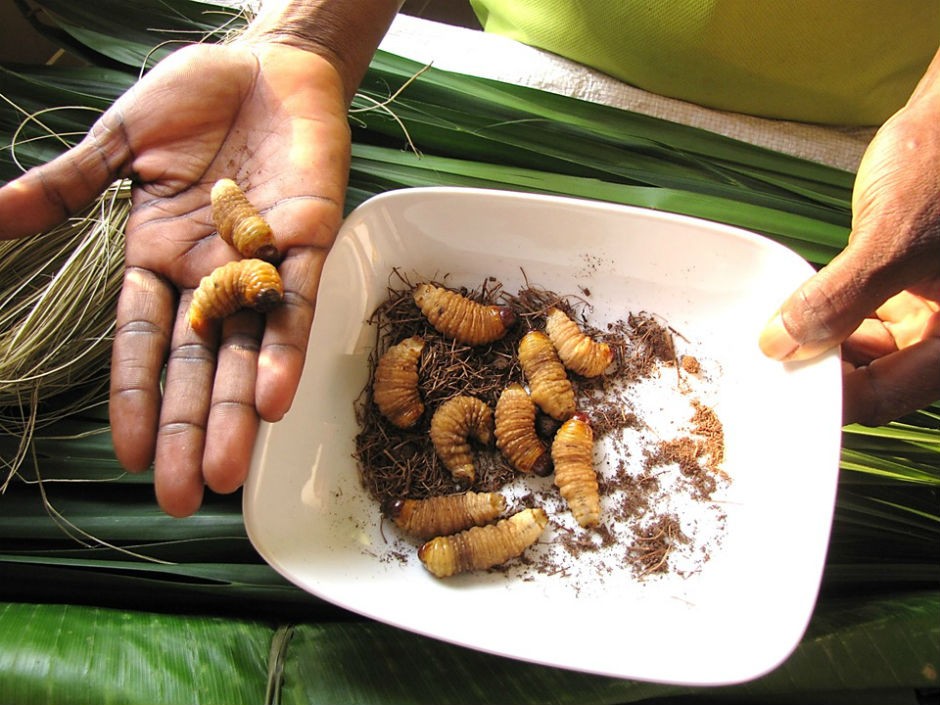Laura Shine is a doctoral candidate in Concordia’s Humanities program, in the fields of food anthropology, food marketing and sensory studies. She investigates the changes in attitudes and behaviours towards novel foods, with a particular focus on entomophagy. She has served as strategic consultant on the board of insect start-ups and presented talks and workshops on eating bugs in schools and university settings. In 2017, she devised and taught an undergraduate course in Food and Culture in Concordia’s Department of Sociology and Anthropology. Her research has been supported by scholarships from the SSHRC and the FQRSC, and by a fellowship from the Luc Beauregard Centre of Excellence in Communications Research.
Blog post
Disgust, part 1: Let's get physical
 Red Palm Weevil Grub from Congo. | Photo: Wikimedia Commons
Red Palm Weevil Grub from Congo. | Photo: Wikimedia Commons
What did you have for breakfast? Cereal with milk? Toast and coffee? A fried egg?
Likely not seasoned, sautéed beetle larvae. White, plump, worm-like things that are both chewy and creamy at the same time. You can see their little legs. They were still writhing a minute ago. You’re picturing them frying in butter in your pan as we speak.
Huh! What a disgusting idea!
You can feel a little something boiling up in your throat at the mere thought of them. Your stomach churns. You were hungry for lunch a minute ago; now you’re not so sure.
What exactly is this curious feeling we call disgust?
In my quest to understand how our ideas about edibility adapt and evolve, I’m constantly confronted with this uniquely human emotion. Edible insects, my particular topic, are especially good at eliciting this. You know the “grossed out” look perfectly well: closed nostrils, a gape, a curling of the upper lip, squinting eyes. I see it all the time when I speak about my research. In fact, you’ve just exhibited these telltale signs yourself at my mention of the sautéed larvae.
But disgust is more than skin-deep, and its many ramifications – both individual and social – are complex and fascinating. In this two-part post, I’ll explore some of the main characteristics of disgust, as well as some little-known aspects that play a large role in our sense of who we are and where we belong.
First comes the physical side of things. I’ve just mentioned some of the more obvious signs, and an unmistakeable facial expression. Disgust also elicits a related action aimed at removing oneself from the elicitor; a particular physiological effect —nausea — and a distinct feeling, namely revulsion. For some specialists, most notably Paul Rozin, the foremost expert on disgust, this emotion is chiefly related to oral incorporation — in other words, eating.
This is certainly linked to the etymology of the English term. It stems from the Latin des (opposite) and gustare (taste), a meaning also conveyed in the French term dégoût, from which disgust originates. Other languages, however, employ very different words to designate the same emotion — a first hint that culture may come into play when talking about disgust.
Eeew! Get that thing away from me!
What causes us to feel disgusted? As far as substances go, nothing is disgusting in itself; any item requires someone to be offended for a specific set of reasons. But some things are more prone than others to elicit the feeling.
Animal products are first on the list: meat, dead critters, even by-products such as milk and eggs are much more likely to gross you out than flowers, grains or grass. Also included in this category are body waste products: faeces, vomit, pus, mucus, etc. Interestingly, as far as our own bodily fluids go, we’re generally only disgusted once they’ve left our body: we have no qualms with swallowing our own spit, or chewed food, while it’s still in our mouth, but we would never drink them out of glass or in a bowl of soup. Here again, the mouth acts as a crucial gateway.
Other researchers add sexual deviance, body-envelope violations, poor hygiene and contact with death to the list of potential elicitors. Generally speaking, reminders of our animal nature, which are typically controlled trough rigid cultural norms, can provoke disgust when they’re not managed properly. All of these suggest there may also exist some more moral strands of disgust. I’ll get back to this a little later on.
Being disgusted by such things may have served some evolutionary functions, as many of them carry the potential to make us seriously ill. For this reason, all cultures have devised precise and stringent, though often very different, ways of dealing with offending items. Where waste should go, how it should be managed, who deals with dead bodies and how: all of these are strictly regulated through cultural norms to prevent contamination and avoid, as much as possible, eliciting disgust.
Chocolate poop
One really fascinating characteristic of disgust is its power of psychological contamination. This includes two “laws of sympathetic magic,” defined by anthropologists Marcel Mauss and James Frazer.
The first law is contagion: "once in contact, always in contact." Think of your own experience: if you find a slug in your salad, do you wash the leaf thoroughly and eat it? Do you throw it away? Do you discard the whole lettuce? Are you turned off all salad for a while? What about when you find a hole in your apple? You know that actual contamination is highly unlikely (not to mention that slugs and apple maggots are, yes, edible). Yet there is something indefinable that still grosses you out.
The second law is similarity: "like produces like." If you were offered a cockroach-shaped liquorice candy, would you eat it without a second thought? Or would the similarity cause you to pause, perhaps even choose to bypass dessert?
Rozin and his colleagues demonstrate through a series of inventive and comical experiments that rational thinking just can’t quite counter the effect of psychological contamination. Among many examples, their study subjects refused to consume soup or juice stirred with a brand-new fly swatter or hair comb. They also preferred chocolate fudge shaped as a muffin to that shaped like dog faeces.
Even though in these cases contamination was impossible, the mere thought association made the items undesirable. In fact, personal contamination can operate in much the same way. Think of it; a disliked person can render a food unpalatable, and you might refuse to eat something made by someone you find disgusting. I’ll address this in more detail in my next post.
We learn to be disgusted
As Rozin and his colleagues examine the origins and ramifications of disgust, they come to the conclusion that the emotion is not innate. Sure, we are born with the capacity for it, but it is acquired over time and through enculturation. Very young children, for instance, show no signs of being disgusted by excrements, nor by other items that frequently elicit disgust among adults, to the latter’s great dismay when they eat earthworms or smear their poop across the wall. Instead, they acquire this disposition during their first years, closely followed by a sensitivity to contamination.
In the next post, I’ll continue this exploration of disgust. Beyond the individual, physical sensations we associate with this emotion, I’ll delve into the ways in which disgust helps outline our sense of identity. As we’ll see, disgust is not only shaped by culture, but it forcefully reshapes culture in its turn. It also serves to establish moral and political boundaries between the self and others, and can easily be imperilled. Until then, I wish you a summer of slug-free salads.
About the author


